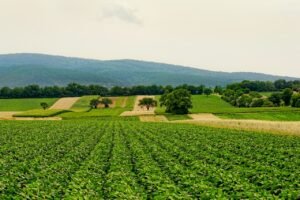
Imagine a world where fresh, nutritious food is readily available in the heart of bustling cities, making it easier than ever to combat food shortages and promote sustainable living. Urban farming, a revolutionary practice that transforms unused urban spaces into thriving green havens, holds the key to making this vision a reality. By utilizing innovative techniques and embracing the power of nature, urban farming is shaping our cities into self-sufficient ecosystems, ensuring a secure and healthy future for all. Discover how this growing movement is redefining the way we approach food security in an urban landscape, as we explore the fascinating world of urban farming.

Defining Urban Farming
What is urban farming?
Urban farming refers to the practice of cultivating and producing food within cities and urban areas. It involves growing crops, raising animals, or cultivating food in various innovative methods such as rooftop farming, vertical farming, indoor farming, and community gardening. Urban farming aims to promote sustainability, increase food security, and reduce the dependence on traditional agricultural methods.
Benefits of urban farming
Urban farming offers numerous benefits for both individuals and communities. Firstly, it provides a local and sustainable food source, reducing the reliance on long-distance transportation and minimizing the carbon footprint associated with food production and distribution. Additionally, urban farming can improve access to fresh and nutritious produce, especially in areas where there are limited grocery stores or lack of fresh food options. It also enhances food security by diversifying food sources and reducing vulnerability to disruptions in the global food supply chain. Urban farming can also contribute to the economic development of cities by creating jobs and promoting local entrepreneurship.
Challenges of urban farming
While urban farming offers many advantages, it also faces several challenges. One of the major obstacles is limited land availability and high real estate costs, making it difficult for urban farmers to secure suitable spaces for cultivation. Urban areas often have zoning and land use regulations that may not support or facilitate agricultural activities, restricting the growth of urban farming initiatives. Additionally, urban farmers may encounter difficulties in accessing water resources and dealing with soil contamination issues. The lack of awareness and education about urban farming practices can also be a challenge, as it requires specialized knowledge and skills. Finally, urban farming may face resistance from traditional agriculture and certain sectors within the community, raising concerns about its feasibility and long-term sustainability.
Food Security and its Importance
Explanation of food security
Food security refers to the availability, accessibility, and affordability of sufficient and nutritious food for all individuals. It encompasses not only the physical access to food but also the nutritional value and safety of the food consumed. Food security is essential for individuals to lead healthy lives, maintain productivity, and foster economic growth. It is a fundamental human right and a critical component of sustainable development.
Global food security challenges
Achieving global food security is a complex challenge due to various factors. Population growth, climate change, water scarcity, and land degradation pose significant threats to the global food supply. The increasing demand for food, coupled with the changing diet preferences and dietary needs, requires innovative solutions to ensure adequate and sustainable food production. In some parts of the world, political instability, conflict, and lack of infrastructure further exacerbate the food security crisis.
Local food security challenges
At the local level, communities may face specific food security challenges. In urban areas, limited access to fresh and nutritious food, commonly known as “food deserts,” can lead to malnutrition and health disparities. The reliance on long-distance transportation and centralized food distribution systems increases the vulnerability of urban communities to disruptions in the supply chain, as seen during the COVID-19 pandemic. Additionally, low-income households may struggle to afford healthy food options, leading to higher rates of food insecurity and related health issues.

The Role of Urban Farming in Food Security
Contributing to local food production
Urban farming plays a crucial role in increasing local food production and enhancing food security at the community level. By cultivating crops, raising animals, and producing food within urban areas, urban farming reduces the dependency on distant agricultural regions and promotes localized food systems. This contributes to a more resilient food supply chain, as urban farmers can respond quickly to fluctuations in demand and mitigate the impact of disruptions in global food production.
Reducing reliance on traditional agriculture
Urban farming offers an alternative to traditional agriculture, which often relies heavily on large-scale farming practices and long-distance transportation. By integrating agriculture into the fabric of cities, urban farming reduces the need for extensive land use and mitigates the environmental impact associated with conventional agriculture, such as deforestation and soil degradation. This shift towards more sustainable farming methods helps preserve natural resources and promotes ecological balance.
Increasing access to fresh and nutritious food
One of the significant advantages of urban farming is its ability to improve access to fresh and nutritious food, especially in underserved communities. By bringing agriculture closer to urban dwellers, urban farming ensures a reliable supply of locally grown produce, reducing the reliance on processed and imported food. This directly addresses the issue of food deserts, as urban farmers can cultivate a wide variety of fruits, vegetables, herbs, and even small livestock within the city limits. Consequently, urban farming promotes healthier eating habits, empowers communities to make informed food choices, and improves overall well-being.
Types of Urban Farming
Rooftop farming
Rooftop farming involves utilizing the roofs of buildings, such as commercial properties or residential complexes, for agricultural purposes. Typically, rooftop farms use specialized growing techniques like container gardening, hydroponics, or aeroponics to maximize space and optimize crop yields. This form of urban farming has gained popularity in densely populated cities with limited open land, as it allows for efficient utilization of available space while providing the multiple benefits of urban farming.
Vertical farming
Vertical farming is a system that grows crops vertically, often in multiple stacked layers or shelves. This method utilizes artificial lighting, climate control systems, and advanced hydroponics or aeroponics techniques to cultivate plants indoors. Vertical farming maximizes the use of vertical space, making it suitable for areas with limited horizontal land availability. It offers high yield potential, reduces water and fertilizer usage, and provides precise control over environmental conditions, resulting in year-round production of fresh produce.
Indoor farming
Similar to vertical farming, indoor farming involves cultivating crops indoors using a controlled environment. It typically utilizes hydroponics or aeroponics systems to provide water and nutrients directly to the plant roots. Indoor farming allows for year-round cultivation, independent of external weather conditions, and provides optimal conditions for plant growth. This method reduces the dependency on traditional agriculture and ensures consistent production of fresh food with minimal water usage and pesticide application.
Community gardening
Community gardening involves the cultivation of food in shared spaces, often within neighborhoods or community centers. These gardens are typically maintained and managed by community members who collectively undertake gardening activities, from planting to harvesting. Community gardening fosters social interactions, improves community cohesion, and promotes the sharing of knowledge and resources. It serves as a platform for education, engagement, and empowerment, allowing individuals to reconnect with nature, learn sustainable practices, and enjoy the benefits of gardening.

Techniques and Technologies in Urban Farming
Hydroponics
Hydroponics is a soil-less farming technique that involves growing plants in nutrient-rich water solutions. This technique replaces traditional soil with a controlled environment where plants receive all essential nutrients directly to their roots. Hydroponics conserves water compared to conventional farming, as the nutrient solution can be recycled and reused. It also eliminates the need for pesticides and herbicides, as plant diseases and pests are easier to manage in a controlled environment.
Aquaponics
Aquaponics combines aquaculture (fish farming) with hydroponics in a symbiotic system. In this technique, fish waste produces nutrient-rich water that is then used to fertilize plants, while the plants filter and purify the water for the fish. This closed-loop system maximizes resource utilization and creates a mutually beneficial relationship between fish and plants. Aquaponics is highly efficient in terms of water usage and nutrient cycling, making it an environmentally friendly and sustainable method of urban farming.
Aeroponics
Aeroponics is a cutting-edge farming technique that involves growing plants in an airborne or mist environment. Plants are suspended in a structure where their roots are periodically misted with a nutrient-rich solution. This allows for maximum oxygen uptake by the roots, promoting rapid growth and high yields. Aeroponics uses minimal water compared to conventional farming methods, making it highly efficient and sustainable. It also eliminates the need for soil and reduces the risk of diseases and pests associated with traditional farming.
Vertical farming systems
Vertical farming systems encompass a range of technologies and methods used in vertical farming. These systems often combine hydroponics or aeroponics with artificial lighting, climate control, and automated nutrient delivery systems. They can be tailored to different types of crops and optimized for specific environmental conditions. Vertical farming systems offer precise control over factors such as temperature, humidity, and lighting, resulting in higher productivity and quality of crops. They are ideal for urban environments where space is limited, allowing for efficient land use and maximizing food production.
Economic and Environmental Benefits of Urban Farming
Job creation and economic development
Urban farming initiatives create employment opportunities, particularly in areas with high unemployment rates or limited job prospects. From farmers and gardeners to researchers, educators, and technicians, urban farming provides a diverse range of jobs across various skill levels. Furthermore, urban farms can stimulate local economies through the sale of produce, value-added products, and agritourism activities. By supporting local businesses and entrepreneurship, urban farming contributes to sustainable economic development and strengthens community resilience.
Reduced carbon footprint
Urban farming significantly reduces the carbon footprint associated with food production and distribution. By cultivating food within cities, urban farms eliminate or minimize the need for long-distance transportation, thereby reducing greenhouse gas emissions. Additionally, urban farming techniques such as hydroponics and vertical farming systems require less land and water compared to traditional agriculture. This conservation of resources, coupled with sustainable farming practices, mitigates the environmental impact of food production and supports climate change mitigation efforts.
Conservation of water resources
Water scarcity is a pressing global challenge, making efficient water usage vital for sustainable agriculture. Urban farming employs advanced irrigation techniques such as drip irrigation, hydroponics, and aeroponics, which use significantly less water compared to traditional irrigation methods. These techniques optimize water usage by delivering water directly to the roots of plants, minimizing evaporation and runoff. Additionally, urban farming promotes water conservation through rainwater harvesting and graywater utilization, further reducing the strain on municipal water supplies.
Urban Farming as a Tool for Social Empowerment
Community engagement and education
Urban farming serves as a platform for community engagement and education, promoting awareness and knowledge about sustainable food systems. Community members can actively participate in the design, cultivation, and maintenance of urban farms, fostering a sense of ownership and empowerment. Urban farms can also be utilized as educational spaces, offering workshops, training programs, and school visits to teach individuals of all ages about ecological principles, healthy eating habits, and urban farming techniques. This engagement strengthens community bonds, improves well-being, and enhances social cohesion.
Addressing food deserts
Food deserts, defined as areas with limited access to affordable and nutritious food, contribute to health inequalities and food insecurity. Urban farming plays a crucial role in addressing food deserts by bringing fresh produce closer to underserved communities. By establishing urban farms in or near these areas, food can be produced locally and distributed through farmers’ markets, community-supported agriculture (CSA) programs, or food cooperatives. This not only improves physical access to nutritious food but also promotes a sense of community and empowerment within these underserved neighborhoods.
Promoting self-sufficiency
Urban farming empowers individuals and communities to become more self-sufficient in terms of food production. By growing their own food, urban farmers gain control over their food sources, reduce reliance on external suppliers, and develop valuable skills. This self-sufficiency enhances food security, especially during emergencies or times of crisis, where disruptions in the global food supply chain may occur. Urban farming also encourages self-reliance, as individuals learn sustainable practices, connect with nature, and develop a deeper appreciation for the food they consume.
Examples of Successful Urban Farming Initiatives
The Farm at Sunnyside (Washington, D.C.)
The Farm at Sunnyside is an urban farm located in Washington, D.C. It operates on a 3.5-acre plot of land and utilizes sustainable farming practices to grow a wide variety of organic vegetables, flowers, and herbs. The farm focuses on community engagement and education, hosting workshops, volunteering opportunities, and farm-to-table events. In addition to supplying fresh produce to local farmers’ markets and restaurants, The Farm at Sunnyside actively promotes food justice and environmental stewardship.
Growing Power (Milwaukee)
Growing Power, based in Milwaukee, Wisconsin, is a pioneering urban farming organization that has transformed vacant urban spaces into thriving agricultural hubs. They utilize a combination of aquaponics, hydroponics, and vermicomposting techniques to produce a diverse range of fruits, vegetables, and fish. Growing Power emphasizes sustainable practices, education, and youth empowerment. They provide hands-on training and support aspiring urban farmers, promote urban agriculture policy, and advocate for food justice.
Brooklyn Grange (New York City)
Brooklyn Grange operates the world’s largest rooftop soil farms, spanning over two acres in total. With locations in Brooklyn and Queens, New York City, Brooklyn Grange grows organic produce, honey, and flowers using sustainable farming methods. Beyond farming, they offer educational programs, host events, and provide green roof consulting services. Brooklyn Grange has pioneered the integration of agriculture into urban landscapes, demonstrating the potential for transforming abandoned spaces into productive and environmentally beneficial sites.
Policy and Regulatory Considerations
Zoning and land use regulations
Urban farming often faces challenges related to zoning and land use regulations. Many cities have strict regulations that restrict or prohibit agricultural activities in certain areas. To facilitate urban farming, policymakers should reassess existing zoning laws and consider designating areas specifically for agricultural uses. This would allow urban farmers to secure suitable land, access necessary resources, and operate within a supportive regulatory framework.
Incentives and support from government
To encourage the growth of urban farming, governments can provide incentives and support to farmers and organizations involved in urban agriculture. This can include financial grants, tax incentives, and access to government-owned or underutilized land for agricultural purposes. Policymakers can also collaborate with urban farming advocates to develop supportive policies, share best practices, and promote knowledge exchange. Public-private partnerships can further enhance the viability and scalability of urban farming initiatives.
Food safety regulations
As with any form of agriculture, urban farming must adhere to food safety regulations to ensure the production of safe and healthy food. Governments should establish clear guidelines and standards for urban farming practices, ensuring compliance with sanitation, pest control, and waste management protocols. Additionally, urban farmers should receive training and education on food safety practices to minimize the risk of contamination and protect public health. By establishing robust food safety regulations, policymakers can ensure that urban farming contributes to food security in a safe and sustainable manner.
Challenges and Future Outlook for Urban Farming
Land availability and affordability
One of the primary challenges for urban farming is the limited availability and high cost of land in urban areas. The competition for land in cities often favors commercial and residential developments over agricultural uses. Policymakers and urban planners need to explore innovative solutions, such as rooftop farming and repurposing underutilized spaces, to address this challenge. Collaborations between local governments, private landowners, and urban farming organizations can help create affordable and accessible land for urban farming initiatives.
Scaling up production
Scaling up urban farming to meet the growing demand for locally produced food presents a significant challenge. Urban farms often operate on small-scale and face limitations due to space constraints and resource availability. To overcome this challenge, technological advancements and improvements in farming techniques are essential. Innovations in vertical farming systems, automation, and energy-efficient technologies can enable farmers to maximize productivity and efficiency. Furthermore, partnerships between urban farmers and local businesses or institutions can support the scaling up of production and facilitate distribution channels.
Integration with existing urban infrastructure
Integrating urban farming into existing urban infrastructure poses challenges related to logistics, utilities, and community acceptance. Urban farms require access to utilities such as water, electricity, and waste management systems, which may need to be adapted or expanded. Collaboration between urban farmers, city planners, and utilities providers can help streamline these infrastructure requirements and ensure their compatibility with urban farming operations. Engaging communities in the planning and design processes is vital to foster acceptance and support for urban farming initiatives.
In conclusion, urban farming plays a vital role in addressing the challenges of food security and promoting sustainable and resilient communities. By contributing to local food production, reducing reliance on traditional agriculture, and increasing access to fresh and nutritious food, urban farming offers numerous benefits. With various types of urban farming, such as rooftop farming, vertical farming, indoor farming, and community gardening, there are diverse ways to practice agriculture within urban areas. Techniques and technologies like hydroponics, aquaponics, aeroponics, and vertical farming systems further enhance urban farming’s efficiency and productivity. Urban farming provides economic and environmental benefits, creates job opportunities, reduces carbon footprint, and conserves water resources. It also serves as a tool for social empowerment, promoting community engagement, addressing food deserts, and fostering self-sufficiency. Successful urban farming initiatives like The Farm at Sunnyside, Growing Power, and Brooklyn Grange demonstrate the feasibility and impact of urban agriculture. However, challenges such as land availability, scaling up production, and integration with existing urban infrastructure must be addressed. Policy and regulatory considerations, including zoning regulations, incentives, and food safety regulations, are crucial for supporting and expanding urban farming. Despite these challenges, the future outlook for urban farming is promising, as communities increasingly recognize its potential to transform cities into sustainable and food-secure environments. By embracing urban farming as a solution, we can create healthier, more resilient, and sustainable cities for all.







